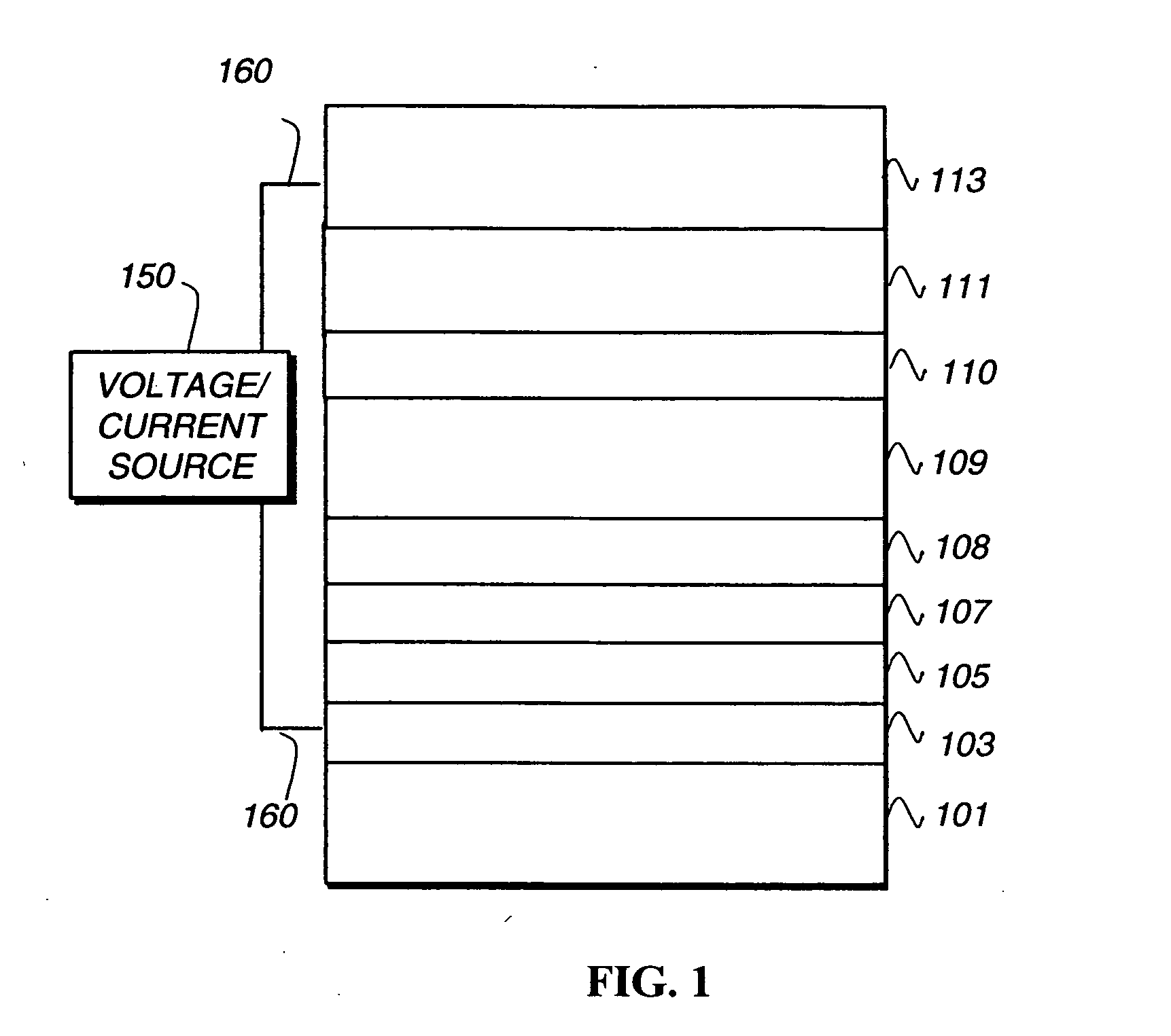Phosphorescent oleds with exciton blocking layer
a technology of exciton blocking layer and phosphorescent oled, which is applied in the direction of discharge tube luminescnet screen, natural mineral layered product, etc., can solve the problems of large loss of efficiency, large excitons created, and performance limitations that have been a barrier to many desirable applications, so as to reduce the drive voltage and improve efficiency.
- Summary
- Abstract
- Description
- Claims
- Application Information
AI Technical Summary
Benefits of technology
Problems solved by technology
Method used
Image
Examples
examples 1-4
DEVICE EXAMPLES 1-4
[0365] An EL device (Device 1) satisfying the requirements of the invention was constructed in the following manner: [0366] 1. A glass substrate, coated with an approximately 85 nm layer of indium-tin oxide (ITO) as the anode, was sequentially ultrasonicated in a commercial detergent, rinsed in deionized water, degreased in toluene vapor and exposed to oxygen plasma for about 1 minute. [0367] 2. Over the ITO was deposited a 1 nm fluorocarbon (CFx) hole injecting layer (HIL) by plasma-assisted deposition of CHF3. [0368] 3. A hole transporting layer (HTL) of N,N′-di-1-naphthyl-N,N′-diphenyl-4,4′-diaminobiphenyl (NPB) having a thickness of 37.5 nm was then evaporated from a resistively heated tantalum boat. [0369] 4. An exciton blocking layer (EBL) of 4,4′,4″-tris(carbazolyl)-triphenylamine (TCTA) having a thickness of 37.5 nm was then evaporated from a resistively heated tantalum boat. [0370] 5. A 35 nm light emitting layer (LEL) consisting of a mixture of 2,2′,2″-(...
examples 5-6
DEVICE EXAMPLES 5-6
[0382] An EL device (Device 5) satisfying the requirements of the invention was fabricated in an identical manner to Device 1 except that about 1 wt. % of lithium was co-deposited with the electron transporting Alq material.
[0383] An EL device (Device 6) also satisfying the requirements of the invention was fabricated in an identical manner to Device 5 except that the Alq layer did not contain lithium.
[0384] The devices were operated at a constant current density of 1 mA / cm2, and voltage and luminance properties were measured. The results are shown in Table 2.
TABLE 2Evaluation Results for EL devices 5 and 6.LuminousyieldVoltageDevice(cd / A)(V)CIExCIEyType551.66.40.340.30Invention650.09.20.330.30Invention
[0385] The results in Table 2 comparing Devices 5 and 6 show that in the practice of the invention, the incorporation of the alkali metal dopant lithium into the electron transporting layer further decreases the drive voltage.
examples 7-8
DEVICE EXAMPLES 7-8
[0386] A EL device (Device 7) satisfying the requirements of the invention was fabricated in an identical manner to Device 1 except that an NPB layer was not deposited, and a 75 nm exciton blocking layer of 1,1-Bis(4-(N,N-di-p-tolylamino)phenyl)cyclohexane (TAPC) was deposited in place of the 37.5 nm layer of TCTA. TAPC is also used in place of TCTA in the LEL at a concentration of 20 wt. % of the total of the co-hosts. Therefore, Device 7 has the following structure of layers: ITO|CFx (1 nm)|TAPC (75 nm)|(TPBI+20 wt. % TAPC)+6 wt. % Ir(ppy)3 (35 nm)|TPBI (10 nm)|Alq (40 nm)|Mg:Ag (220 nm).
[0387] A comparative EL device (Device 8) not satisfying the requirements of the invention was fabricated in an identical manner to Device 7 except TAPC was not included in the LEL and TPBI was used as a neat host for Ir(ppy)3.
[0388] These devices were operated at a constant current density of 1 mA / cm2, and voltage and luminance properties were measured. The results are shown ...
PUM
| Property | Measurement | Unit |
|---|---|---|
| triplet energy | aaaaa | aaaaa |
| thick | aaaaa | aaaaa |
| operating voltages | aaaaa | aaaaa |
Abstract
Description
Claims
Application Information
 Login to View More
Login to View More - R&D
- Intellectual Property
- Life Sciences
- Materials
- Tech Scout
- Unparalleled Data Quality
- Higher Quality Content
- 60% Fewer Hallucinations
Browse by: Latest US Patents, China's latest patents, Technical Efficacy Thesaurus, Application Domain, Technology Topic, Popular Technical Reports.
© 2025 PatSnap. All rights reserved.Legal|Privacy policy|Modern Slavery Act Transparency Statement|Sitemap|About US| Contact US: help@patsnap.com



